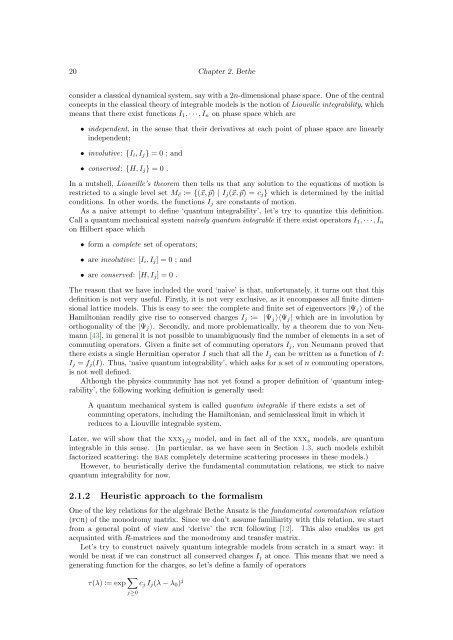The Bethe/Gauge Correspondence
The Bethe/Gauge Correspondence
The Bethe/Gauge Correspondence
You also want an ePaper? Increase the reach of your titles
YUMPU automatically turns print PDFs into web optimized ePapers that Google loves.
20 Chapter 2. <strong>Bethe</strong>consider a classical dynamical system, say with a 2n-dimensional phase space. One of the centralconcepts in the classical theory of integrable models is the notion of Liouville integrability, whichmeans that there exist functions I 1 , · · ·, I n on phase space which are• independent, in the sense that their derivatives at each point of phase space are linearlyindependent;• involutive: {I i , I j } = 0 ; and• conserved: {H, I j } = 0 .In a nutshell, Liouville’s theorem then tells us that any solution to the equations of motion isrestricted to a single level set M ⃗c := {(⃗x, ⃗p) | I j (⃗x, ⃗p) = c j } which is determined by the initialconditions. In other words, the functions I j are constants of motion.As a naive attempt to define ‘quantum integrability’, let’s try to quantize this definition.Call a quantum mechanical system naively quantum integrable if there exist operators I 1 , · · ·, I non Hilbert space which• form a complete set of operators;• are involutive: [I i , I j ] = 0 ; and• are conserved: [H, I j ] = 0 .<strong>The</strong> reason that we have included the word ‘naive’ is that, unfortunately, it turns out that thisdefinition is not very useful. Firstly, it is not very exclusive, as it encompasses all finite dimensionallattice models. This is easy to see: the complete and finite set of eigenvectors |Ψ j 〉 of theHamiltonian readily give rise to conserved charges I j := |Ψ j 〉〈Ψ j | which are in involution byorthogonality of the |Ψ j 〉. Secondly, and more problematically, by a theorem due to von Neumann[43], in general it is not possible to unambiguously find the number of elements in a set ofcommuting operators. Given a finite set of commuting operators I j , von Neumann proved thatthere exists a single Hermitian operator I such that all the I j can be written as a function of I:I j = f j (I). Thus, ‘naive quantum integrability’, which asks for a set of n commuting operators,is not well defined.Although the physics community has not yet found a proper definition of ‘quantum integrability’,the following working definition is generally used:A quantum mechanical system is called quantum integrable if there exists a set ofcommuting operators, including the Hamiltonian, and semiclassical limit in which itreduces to a Liouville integrable system.Later, we will show that the xxx 1/2 model, and in fact all of the xxx s models, are quantumintegrable in this sense. (In particular, as we have seen in Section 1.3, such models exhibitfactorized scattering: the bae completely determine scattering processes in these models.)However, to heuristically derive the fundamental commutation relations, we stick to naivequantum integrability for now.2.1.2 Heuristic approach to the formalismOne of the key relations for the algebraic <strong>Bethe</strong> Ansatz is the fundamental commutation relation(fcr) of the monodromy matrix. Since we don’t assume familiarity with this relation, we startfrom a general point of view and ‘derive’ the fcr following [12]. This also enables us getacquainted with R-matrices and the monodromy and transfer matrix.Let’s try to construct naively quantum integrable models from scratch in a smart way: itwould be neat if we can construct all conserved charges I j at once. This means that we need agenerating function for the charges, so let’s define a family of operatorsτ(λ) := exp ∑ j≥0c j I j (λ − λ 0 ) j
















